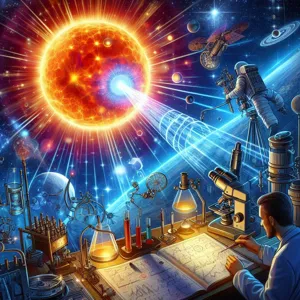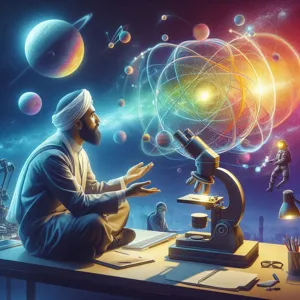The universe, a vast expanse filled with dazzling stars, enigmatic galaxies, and uncharted cosmic phenomena, has captivated humanity for centuries.
Yet, despite our awe, much remains shrouded in mystery. Enter the powerful tool of spectroscopy—a technique that allows astronomers to decode the light emitted or absorbed by celestial bodies, revealing their composition, temperature, distance, and even the very processes that govern them. In this blog post, we will embark on a journey to explore how spectroscopy acts as a cosmic key, unlocking the secrets of the universe. From deciphering the atmospheres of distant exoplanets to understanding the life cycles of stars, we’ll delve into the fascinating applications of this science and the groundbreaking discoveries that have reshaped our understanding of the cosmos. Join us as we uncover the remarkable ways in which astronomers harness the spectrum of light to illuminate the dark corners of space and time!
1. Introduction to Spectroscopy: What Is It?

Spectroscopy is a powerful analytical technique that allows astronomers to decipher the secrets of the universe, revealing the composition, temperature, density, and motion of celestial objects. At its core, spectroscopy involves the study of the interaction between light and matter. When light from a star or galaxy passes through a prism or diffraction grating, it is separated into its constituent colors, creating a spectrum. This spectrum provides a wealth of information, acting much like a cosmic fingerprint that tells astronomers about the elements present in the astronomical body being observed.
The electromagnetic spectrum encompasses a wide range of wavelengths, from radio waves to gamma rays, and each segment carries unique information. For example, visible light, which is just a small portion of the entire spectrum, can reveal the chemical makeup of distant stars. When specific wavelengths of light are absorbed or emitted by elements, they produce distinct lines in the spectrum known as absorption or emission lines. By analyzing these lines, astronomers can identify the elements present, determine their temperatures, and even infer their velocities through the Doppler effect.
Spectroscopy is not just confined to the observation of stars. It is instrumental in studying galaxies, nebulae, and even the atmospheres of exoplanets. As telescopes and spectroscopic instruments become increasingly sophisticated, the ability to unlock the mysteries of the cosmos continues to expand. From revealing the life cycles of stars to providing clues about the formation of galaxies, spectroscopy is a crucial tool in the astronomer’s toolkit, enabling us to better understand the universe in which we reside.
2. The History of Spectroscopy in Astronomy
The history of spectroscopy in astronomy is a captivating tale that intertwines scientific discovery with the quest for understanding the universe. This method, which involves analyzing the light emitted or absorbed by celestial bodies, has roots dating back to the early 19th century. In 1814, the pioneering work of Joseph von Fraunhofer marked a monumental moment when he identified dark lines in the solar spectrum, later known as Fraunhofer lines. These lines represented specific wavelengths of light absorbed by elements in the Sun’s atmosphere, laying the groundwork for what would evolve into a powerful tool for astronomers.
As the 19th century progressed, scientists like Gustav Kirchhoff and Robert Bunsen expanded upon Fraunhofer’s initial findings. They formulated the fundamental principles of spectroscopy, establishing that each element emits and absorbs light at characteristic wavelengths—essentially, a cosmic fingerprint. This revelation allowed astronomers to decode the composition of stars and other celestial objects, offering insights into their temperatures, densities, and even motions.
The 20th century ushered in a new era for spectroscopy with the advent of advanced instruments and technology. Telescopes equipped with spectrographs began to emerge, enabling astronomers to capture detailed spectra from distant galaxies and nebulae. This technological leap was instrumental in the discovery of the expanding universe, as Edwin Hubble employed redshift measurements—derived from spectral analysis—to demonstrate that galaxies were moving away from us, a pivotal finding that reshaped our understanding of cosmology.
Today, spectroscopy remains a cornerstone of modern astronomy, providing a window into the physical and chemical properties of the cosmos. From characterizing the atmospheres of exoplanets to unraveling the mysteries of stellar formation, the historical evolution of spectroscopy encapsulates a journey of human curiosity and ingenuity, continually unlocking the secrets of the stars above us.
3. Understanding the Basics: How Spectroscopy Works

To dive into the captivating world of spectroscopy, it’s essential to grasp the fundamental principles that govern this powerful analytical technique. At its core, spectroscopy is the study of how matter interacts with electromagnetic radiation. Imagine a prism separating white light into a vibrant rainbow of colors; this phenomenon is akin to what happens in spectroscopy, where light is used to probe the composition and properties of distant celestial objects.
When astronomers observe a star or galaxy, they collect its emitted light, which contains a wealth of information encoded within it. This light is then passed through a spectrometer, an instrument designed to break it down into its constituent wavelengths. As the light disperses, it reveals a spectrum—a unique fingerprint that reflects the elemental makeup of the celestial body.
Each element emits or absorbs light at specific wavelengths, producing distinct patterns known as spectral lines. For instance, hydrogen, the most abundant element in the universe, has a characteristic pattern of lines that appear in the spectrum. By analyzing these lines, astronomers can identify the elements present in a star, determine its temperature, gauge its velocity, and even infer its distance from Earth.
Moreover, spectroscopy is not limited to visible light. Astronomers utilize a range of electromagnetic radiation—from radio waves to gamma rays—allowing them to explore the universe across different wavelengths. This multi-wavelength approach provides a more comprehensive understanding of cosmic phenomena, revealing details that may be missed by traditional observational methods.
In essence, spectroscopy transforms light into a cosmic language, enabling astronomers to decode the secrets of the universe. By unraveling the intricate patterns woven into starlight, they can explore the lifecycle of stars, the formation of galaxies, and the mysterious forces that govern the cosmos. Understanding how spectroscopy works not only enriches our knowledge of the universe but also ignites our curiosity about the endless possibilities that await in the vast expanse of space.
4. Types of Spectroscopy Used in Astronomy
Spectroscopy is a powerful tool in the hands of astronomers, allowing them to decipher the intricate messages encoded in the light emitted and absorbed by celestial bodies. By studying the spectrum of light, astronomers can glean vital information about the composition, temperature, density, mass, distance, and relative motion of stars and galaxies. Here are some of the key types of spectroscopy employed in astronomy:
### 1. **Optical Spectroscopy**
Optical spectroscopy is the most common form used in astronomy. It involves analyzing the visible light emitted by stars, planets, and other celestial objects. By dispersing this light into its constituent colors using prisms or diffraction gratings, astronomers can identify specific spectral lines that indicate the presence of various elements and molecules. This technique is essential for determining the chemical composition of stars and the atmospheres of exoplanets.
### 2. **Infrared Spectroscopy**
Infrared spectroscopy allows astronomers to study objects that are too cool to emit visible light, such as dust clouds and newly forming stars. Infrared wavelengths can penetrate dust better than visible light, revealing hidden structures and phenomena. This method is invaluable in understanding star formation and the dynamics of molecular clouds, as well as in detecting and analyzing the atmospheric composition of distant exoplanets.
### 3. **Radio Spectroscopy**
Radio spectroscopy involves the use of radio waves to explore the universe. By observing the radio emissions from celestial objects, astronomers can study phenomena such as the cosmic microwave background radiation and the emissions from pulsars and quasars. This type of spectroscopy is crucial for understanding the large-scale structure of the universe and for investigating the fundamental processes that govern the behavior of cosmic matter.
### 4. **X-ray Spectroscopy**
X-ray spectroscopy is employed to study extremely hot and energetic celestial phenomena, such as black holes, neutron stars, and supernova remnants. When high-energy events occur, they emit X-rays that can be captured by specialized telescopes. By analyzing the X-ray spectrum, astronomers can determine the physical conditions of these extreme environments, including temperature, density, and chemical composition, shedding light on some of the most mysterious and violent processes in the universe.
### 5. **Ultraviolet Spectroscopy**
Ultraviolet spectroscopy focuses on the UV light emitted by hot stars and the interstellar medium. This technique is crucial for understanding the properties of high-energy processes and the ionization of gases in space. Ultraviolet observations can reveal insights into the lifecycle of stars, the chemical evolution of galaxies, and the dynamics of supernova remnants.
Each of these spectroscopy methods provides a unique lens through which astronomers can explore the cosmos, revealing the rich tapestry of the universe and answering fundamental questions about its origin and evolution. By harnessing the power of these techniques, scientists continue to unlock the secrets of the stars, one spectrum at a time.
5. The Role of Light: Why Spectra Matter

The role of light in the universe is nothing short of magical, and understanding its intricacies is crucial for astronomers seeking to unlock the secrets of the cosmos. Light, as an electromagnetic wave, carries with it a wealth of information about celestial objects, and this is where the fascinating science of spectroscopy comes into play. When we observe light emitted or absorbed by stars and other cosmic entities, we are essentially looking at a unique fingerprint—one that reveals the composition, temperature, density, mass, distance, luminosity, and motion of these distant bodies.
Spectra, the patterns formed when light is separated into its constituent colors or wavelengths, serve as invaluable tools for astronomers. Each element in the universe interacts with light in distinct ways, leading to specific absorption and emission lines in the spectrum. For instance, the presence of hydrogen can be identified by its characteristic spectral lines, allowing astronomers to ascertain not just its abundance in stars but also the conditions under which it exists.
Moreover, spectra provide insights into the physical state of celestial objects. The width of spectral lines can indicate the temperature and pressure of a star’s atmosphere, while shifts in these lines can reveal information about the object’s motion through space—whether it’s moving towards or away from us. This principle, known as the Doppler effect, enables scientists to measure the velocity of stars and galaxies, offering clues about the expansion of the universe itself.
In summary, spectra matter because they are the keys to understanding the universe’s composition and behavior. Through the analysis of light, astronomers can piece together the complex puzzle of cosmic phenomena, transforming what once seemed like distant mysteries into comprehensible knowledge. As they continue to refine spectroscopic techniques and technology, they are not just studying the stars—they are unraveling the very fabric of the universe.
6. Identifying Elements in Stars: The Chemical Fingerprint
Identifying elements in stars is akin to reading a cosmic signature, a chemical fingerprint that reveals the fundamental building blocks of the universe. Each star emits light that can be analyzed through spectroscopy, a technique that splits light into its component colors, much like a prism reveals the spectrum of a rainbow. This spectrum contains distinct lines, or fingerprints, that correspond to specific elements and molecules present in the star.
When astronomers observe the light from a star, they use spectrometers to capture this spectrum. Each element absorbs and emits light at characteristic wavelengths, creating a unique pattern of lines that scientists can interpret. For instance, hydrogen, the most abundant element in the universe, produces a series of lines that are easily recognizable. By comparing the observed spectrum to known wavelengths, astronomers can determine which elements are present and in what quantities, providing insights into the star’s composition, age, and evolutionary state.
This method of analysis is not just limited to stars. It extends to entire galaxies, nebulae, and even exoplanets, offering a glimpse into their chemical compositions and the processes that govern their formation and evolution. The ability to discern the elemental makeup of celestial bodies allows astronomers to understand the lifecycle of stars, the formation of planetary systems, and the very origins of the elements that make up our own planet and life itself.
As we decode these cosmic fingerprints, we unlock the secrets of the universe, piecing together the stories of stellar birth and death, and revealing the intricate web of connections that bind us to the stars above.
7. Measuring Temperature and Density of Celestial Bodies

Spectroscopy is an invaluable tool in the arsenal of astronomers, allowing them to delve into the intricate details of celestial bodies, including their temperature and density. By analyzing the light emitted or absorbed by stars and other astronomical objects, scientists can gain insights into their physical conditions, which are often beyond the reach of traditional observational methods.
When light from a star passes through a prism or diffraction grating, it breaks into its constituent colors, creating a spectrum. This spectrum contains unique patterns of absorption and emission lines, which act like fingerprints for each element present in the star’s atmosphere. By examining these lines closely, astronomers can determine the specific wavelengths of light corresponding to various elements, such as hydrogen, helium, and heavier metals. Each element has a distinct spectral signature, allowing scientists to identify its presence and abundance in the star’s composition.
To measure temperature, astronomers employ a technique called blackbody radiation analysis. Every object emits light based on its temperature, with hotter objects radiating light at shorter wavelengths. By analyzing the spectrum of a star and identifying the peak wavelength of its emitted light, astronomers can use Wien’s Law to accurately gauge its surface temperature. This technique has revealed that stars can range from a cool 2,000 degrees Kelvin to an astonishing 50,000 degrees Kelvin, providing crucial information about their life stages and evolutionary processes.
Density measurements, on the other hand, are trickier but equally fascinating. By studying the gravitational effects that a celestial body exerts on nearby objects, astronomers can infer its mass. Combining this information with measurements of its volume—often derived from its physical size and brightness—allows for the calculation of density. This is particularly important in understanding the composition of stars, planets, and even distant galaxies. For instance, the differences in density between gas giants and terrestrial planets reveal much about their formation and the materials that make them up.
Through the meticulous application of spectroscopy, astronomers can not only gauge the temperature and density of celestial bodies but also piece together the intricate puzzle of the universe’s history and structure. By unlocking these cosmic secrets, we gain a deeper appreciation for the complex and dynamic nature of the cosmos, as well as our place within it.
8. Unraveling Stellar Evolution through Spectroscopy
Spectroscopy serves as a powerful tool for astronomers aiming to unravel the complex story of stellar evolution. By analyzing the light emitted or absorbed by stars, scientists can glean critical insights into their composition, temperature, age, and even their evolutionary stage. Each star emits a unique spectrum of light, much like a fingerprint, which contains information about the elements present within it.
As light travels through the universe, it interacts with matter, and the resulting spectra reveal a wealth of information. For instance, the presence of certain lines in a star’s spectrum can indicate the abundance of elements such as hydrogen, helium, carbon, and iron. These elements are not merely decorative; they play essential roles in the nuclear fusion processes that power stars. By studying these spectral lines, astronomers can determine where a star is in its life cycle—whether it’s a young protostar, a stable main-sequence star, or nearing the end of its life as a red giant or supernova.
Moreover, spectroscopy allows researchers to observe the effects of stellar winds and mass loss, phenomena that significantly influence a star’s evolution. By measuring the Doppler shifts in the spectra, astronomers can gauge the speed and direction of a star’s movement, shedding light on the dynamics of stellar environments.
In recent years, advancements in spectroscopy have enabled astronomers to conduct more precise measurements and analyze fainter and more distant stars than ever before. This has opened new avenues for understanding not just individual stars but also the broader processes governing stellar populations within galaxies. As we continue to unlock the secrets of the cosmos, spectroscopy remains a crucial key, illuminating the journey of stars from their fiery births to their spectacular ends.
9. Spectroscopy in the Search for Exoplanets
Spectroscopy has revolutionized the search for exoplanets, those intriguing worlds orbiting stars beyond our own solar system. By analyzing the light emitted or absorbed by stars, astronomers can glean invaluable information about distant planets and their potential for habitability. When a planet passes in front of its host star—a phenomenon known as a transit—it blocks a fraction of the starlight, causing a temporary dip in brightness. This is where spectroscopy comes into play.
As the star’s light filters through the planet’s atmosphere, it interacts with the gases present, producing a unique spectral signature. By examining this spectrum, scientists can identify the chemical composition of the atmosphere, detecting essential elements such as water vapor, carbon dioxide, and even oxygen. These markers are crucial in assessing whether an exoplanet lies within the habitable zone, where conditions might be suitable for life.
The technique of transmission spectroscopy enables astronomers to infer details about an exoplanet’s size, temperature, and atmospheric properties with remarkable precision. For instance, the Hubble Space Telescope has utilized this method to study the atmospheres of several exoplanets, unveiling the presence of clouds and potential weather patterns. More recently, the James Webb Space Telescope has taken this research a step further, allowing for even more detailed analyses of exoplanet atmospheres and expanding our understanding of these distant worlds.
As researchers continue to refine their spectroscopic techniques, the search for exoplanets becomes not just a quest for new planets, but a deeper exploration of the universe’s potential for life. Each discovery brings us closer to answering the age-old question: Are we alone in the cosmos? Through the lens of spectroscopy, the stars are not just points of light; they are gateways to understanding the myriad possibilities that lie beyond our Earth.
10. The Impact of Redshift and Blueshift in Cosmology
In the vast expanse of the universe, the phenomena of redshift and blueshift play pivotal roles in our understanding of cosmic dynamics and the fabric of space-time. These shifts in the wavelength of light, caused by the motion of celestial objects relative to an observer, serve as essential tools for astronomers seeking to decode the mysteries of the cosmos.
Redshift, which occurs when an object in space moves away from an observer, causes the light waves emitted by that object to stretch, resulting in a shift toward the red end of the spectrum. This phenomenon provides crucial evidence for the expansion of the universe. By analyzing the redshift of distant galaxies, astronomers can measure how fast these galaxies are receding from us, offering insights into the rate of cosmic expansion. The more pronounced the redshift, the faster a galaxy is moving away, allowing researchers to piece together the history of the universe itself and inform models of its future trajectory.
Conversely, blueshift is observed when an object moves closer to an observer, compressing the light waves and shifting the spectrum toward the blue end. This effect is less common on a cosmic scale but can be observed in certain astronomical events, such as the movement of some galaxies towards the Milky Way, or the rapid motion of stars within our galaxy. By studying blueshift, astronomers can gather data on the dynamics of star clusters and the gravitational interactions happening within them.
The implications of redshift and blueshift extend beyond simple motion; they are key indicators of the universe’s structure and evolution. Understanding these shifts enables scientists to explore the distribution of galaxies, the influence of dark energy, and the fabric of space itself. As researchers continue to refine their spectroscopic techniques, the insights gained from redshift and blueshift promise to unlock even deeper cosmic mysteries, ultimately enhancing our understanding of the universe and our place within it.
11. Case Studies: Spectroscopy Discoveries in Astronomy
Spectroscopy has revolutionized our understanding of the universe, revealing secrets hidden within the light emitted by celestial objects. Through a series of case studies, we can appreciate the profound impact this technique has had on astronomy.
One of the most iconic examples is the discovery of the chemical composition of stars. In the early 19th century, the pioneering work of scientists like Joseph von Fraunhofer laid the foundation for stellar spectroscopy. By analyzing the absorption lines in the spectrum of sunlight, astronomers were able to identify elements such as hydrogen, helium, and heavier metals. This breakthrough not only confirmed the existence of these elements in distant stars but also allowed scientists to deduce their abundance and understand stellar evolution.
Another landmark case is the application of spectroscopy in determining the redshift of distant galaxies. In the 1920s, Edwin Hubble utilized this technique to measure the spectral lines of galaxies, revealing that they were moving away from us. This observation led to the formulation of Hubble’s Law, which established that the universe is expanding—a discovery that fundamentally altered our comprehension of the cosmos and laid the groundwork for the Big Bang theory.
More recently, spectroscopy has played a crucial role in exoplanet research, particularly in the quest for potentially habitable worlds. By studying the light that filters through the atmosphere of distant planets during transits (when a planet passes in front of its star), astronomers can identify the chemical signatures of gases such as water vapor, methane, and carbon dioxide. This method has led to the exciting discovery of potentially habitable exoplanets, sparking discussions about the possibility of life beyond Earth.
These case studies exemplify the versatility of spectroscopy in addressing fundamental questions about the universe. From unveiling the composition of stars to uncovering the mysteries of distant galaxies and searching for life on exoplanets, spectroscopy continues to be an indispensable tool for astronomers, unlocking the stars and expanding our understanding of the cosmos. As technology advances, we can only anticipate even more groundbreaking discoveries that will further illuminate our place in the universe.
12. Advances in Spectroscopic Technology
In the ever-evolving field of astronomy, advances in spectroscopic technology have revolutionized our understanding of the cosmos. Spectroscopy, the study of the interaction between matter and electromagnetic radiation, has become an indispensable tool for astronomers seeking to decode the secrets of the universe. With each leap in technological innovation, researchers are gaining unprecedented insights into the composition, temperature, density, and motion of celestial objects.
One of the most significant advancements in recent years has been the development of high-resolution spectrographs. These sophisticated instruments can analyze light from distant stars and galaxies with remarkable precision, allowing astronomers to detect even the faintest spectral lines. This heightened sensitivity has led to groundbreaking discoveries, such as the identification of exoplanet atmospheres and the detection of complex organic molecules in interstellar space.
Additionally, the integration of infrared and ultraviolet spectroscopy has expanded the range of wavelengths astronomers can study. By capturing data across a broader spectrum, scientists can probe the cooler and more distant regions of the universe, revealing previously hidden phenomena. Innovations like the James Webb Space Telescope, equipped with advanced spectroscopic capabilities, promise to push the boundaries of our knowledge even further, enabling us to observe the formation of stars, galaxies, and even the conditions that might support life beyond Earth.
Moreover, the rise of machine learning and artificial intelligence in data analysis is enhancing the efficiency and accuracy of spectroscopic studies. These technologies are helping astronomers to sift through vast datasets, identifying patterns and anomalies that might go unnoticed by the human eye. As a result, the pace of discovery is accelerating, allowing researchers to make connections and hypotheses that were once thought to be years away.
As we stand on the brink of a new era in astronomical research, the advances in spectroscopic technology not only enrich our understanding of the universe but also inspire a sense of wonder about what lies beyond our planet. Each new discovery fueled by these technologies unlocks further mysteries, inviting us to explore the depths of space with renewed curiosity and excitement.
13. Future of Spectroscopy: What Lies Ahead for Astronomy?
As we stand at the intersection of innovation and exploration, the future of spectroscopy in astronomy promises to be as dazzling as the stars themselves. With advancements in technology and a deepening understanding of the universe, astronomers are poised to unlock new cosmic mysteries that have long eluded us. The next generation of telescopes, such as the James Webb Space Telescope, is equipped with state-of-the-art spectroscopic capabilities that allow scientists to analyze the light from distant celestial bodies with unprecedented precision.
One of the most exciting prospects on the horizon is the development of ultra-high-resolution spectroscopy. This technique will enable astronomers to discern the faintest spectral lines, which are crucial for understanding the composition and behavior of exoplanets, stars, and galaxies. By capturing these subtle shifts in light, astronomers can glean vital information about the atmospheres of exoplanets, searching for signs of habitability or even life itself.
Moreover, advancements in computational power and data analysis techniques, such as machine learning and artificial intelligence, are set to revolutionize how we interpret spectroscopic data. These tools can process vast amounts of information in real time, identifying patterns and anomalies that might take human researchers years to uncover. The integration of AI could lead to rapid breakthroughs in our understanding of dark matter, cosmic inflation, and the formation of galaxies.
In addition to these technological advancements, collaborations between international space agencies and research institutions are expected to flourish, resulting in ambitious projects that push the boundaries of what we know about the universe. Future missions may include spectroscopic surveys of the entire sky, mapping the chemical evolution of galaxies, or even investigating the cosmic background radiation to learn more about the origins of the universe itself.
As we look to the future of spectroscopy in astronomy, one thing is certain: the quest to understand our cosmos is far from over. With each new discovery, we inch closer to answering some of humanity’s most profound questions about the nature of existence, the potential for life beyond Earth, and the intricate workings of the universe. The stars are not just points of light; they are keys to unlocking the mysteries of our cosmic heritage, and spectroscopy will continue to be the instrument that helps us decode their secrets.
14. Conclusion: The Significance of Spectroscopy in Understanding the Universe
In conclusion, spectroscopy stands as a cornerstone of modern astronomy, a powerful tool that enables scientists to decode the intricate patterns of light emitted by celestial bodies. By analyzing the spectral fingerprints of stars, planets, and galaxies, astronomers can uncover a wealth of information about their composition, temperature, density, mass, distance, luminosity, and relative motion. This non-invasive method transforms light into a treasure trove of data, allowing researchers to explore the universe’s past, present, and future with unparalleled precision.
The significance of spectroscopy extends beyond mere observation; it acts as a bridge connecting us to the cosmos. It reveals the life cycles of stars, the chemistry of distant worlds, and the dynamics of cosmic phenomena, paving the way for groundbreaking discoveries such as the expansion of the universe and the presence of exoplanets in habitable zones. As technology continues to advance, the capabilities of spectroscopic analysis will only improve, granting astronomers deeper insights into the fundamental processes that govern the universe.
Moreover, spectroscopy is not confined to the realm of astronomy. Its principles and applications resonate across various scientific fields, including chemistry, biology, and environmental science, making it an invaluable asset in our quest for knowledge. Ultimately, spectroscopy not only enriches our understanding of the universe but also ignites our curiosity, inviting us to ponder the mysteries of existence and our place within the cosmic tapestry. As we look to the stars, it is through the lens of spectroscopy that we unlock the secrets of the universe, one spectrum at a time.
15. Resources for Further Exploration in Astronomical Spectroscopy
If you’re captivated by the wonders of astronomical spectroscopy and eager to delve deeper into this fascinating field, a wealth of resources awaits you. Whether you’re a budding astronomer, an experienced researcher, or simply a curious enthusiast, these tools and materials can enhance your understanding and inspire your cosmic explorations.
**Books and Texts:** consider starting with seminal texts such as “Spectroscopy of Astronomical Objects” by David A. Allen, which offers a comprehensive overview of the techniques and applications of spectroscopy in astronomy. Another excellent resource is “Introduction to Astronomical Spectroscopy” by David S. Smith, which serves as both a textbook and a reference guide, perfect for those new to the topic.
**Online Courses:** Platforms like Coursera and edX offer courses specifically focused on astrophysics and spectroscopy. These courses often feature lectures from leading experts in the field, interactive quizzes, and forums for discussion with fellow learners, making them a perfect way to deepen your knowledge from the comfort of your home.
**Websites and Journals:** The American Astronomical Society (AAS) and the International Astronomical Union (IAU) maintain a trove of resources, including research papers, articles, and the latest findings in the realm of spectroscopy. Websites like NASA’s Astrophysics Data System provide access to a vast library of scholarly articles that you can explore at your own pace.
**Software Tools:** Familiarizing yourself with software like IRAF (Image Reduction and Analysis Facility) or Python libraries such as AstroPy can be invaluable for hands-on practice. These tools allow you to analyze spectral data, helping you to understand how spectroscopy is applied in real-world astronomical research.
**Community Engagement:** Joining forums and online communities, such as Reddit’s r/astronomy or specialized groups on platforms like Facebook, can connect you with like-minded individuals. These communities are often buzzing with discussions about the latest discoveries, practical advice, and shared experiences in the field of astronomical spectroscopy.
By tapping into these resources, you’ll not only enhance your comprehension of spectroscopy but also open up pathways for your own cosmic discoveries. The universe is vast, and with the right tools and knowledge, you can play a part in unraveling its many mysteries. Happy exploring!
In conclusion, spectroscopy not only serves as a powerful tool for astronomers but also opens a captivating window into the universe’s secrets. Through the analysis of light from distant stars and galaxies, we can decipher their composition, temperature, and even their motion through space. As we continue to refine these techniques and expand our technological capabilities, the mysteries of the cosmos become more accessible, revealing the intricate tapestry of our universe. We encourage you to embrace the wonders of spectroscopy and consider how this remarkable science allows us to connect with the stars above. The next time you gaze at the night sky, remember that each twinkle holds a story waiting to be unveiled, and with spectroscopy, we are just beginning to unlock those celestial narratives. Thank you for joining us on this astronomical journey!






